ASUS F2A85-V Pro Review: A Look at FM2 with A85X
by Ian Cutress on October 10, 2012 11:20 AM EST- Posted in
- Motherboards
- Asus
- Trinity
- FM2
- A85X
USB Speed
For this benchmark, we run CrystalDiskMark to determine the ideal sequential read and write speeds for the USB port using our 240 GB OCZ Vertex3 SSD with a SATA 6 Gbps to USB 3.0 converter. Then we transfer a set size of files from the SSD to the USB drive using DiskBench, which monitors the time taken to transfer. The files transferred are a 1.52 GB set of 2867 files across 320 folders – 95% of these files are small typical website files, and the rest (90% of the size) are the videos used in the Sorenson Squeeze test.
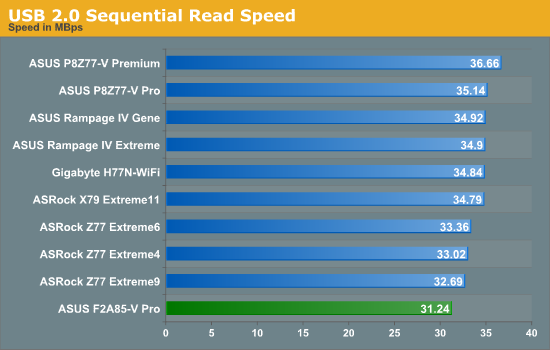
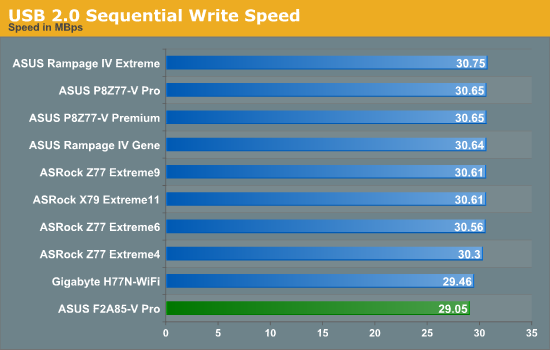
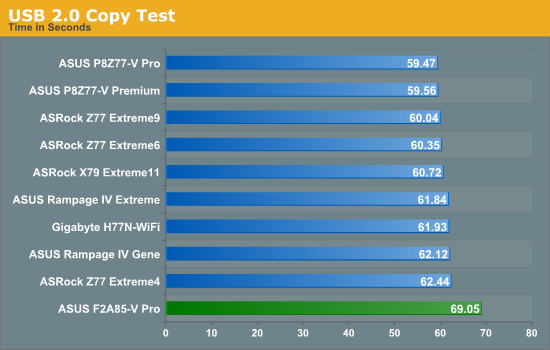
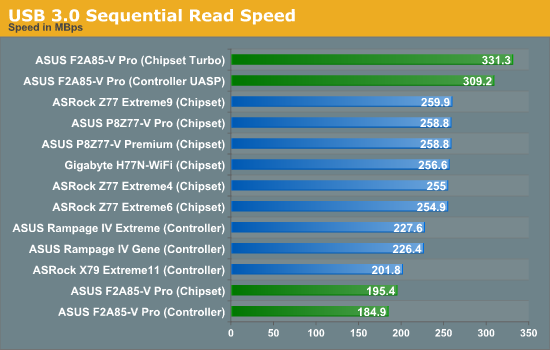


For whatever reason, our standard USB testing regimen on AMD systems shows a slight speed deficiency compared to the Intel systems. In USB 3.0 our copy tests are more than 10% slower on an AMD system.
SATA Testing
We also use CrystalDiskMark for SATA port testing on a C300 drive. The sequential test (incompressible data) is run at the 5 x 1000 MB level. This test probes the efficiency of the data delivery system between the chipset and the drive, or in the case of additional SATA ports provided by a third party controller, the efficiency between the controller, the chipset and the drive.

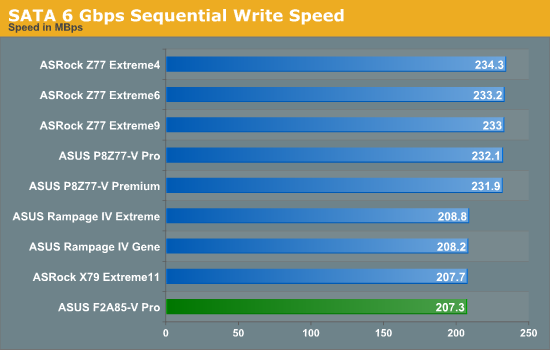
I really like the fact that the AMD chipset is SATA 6 Gbps only, although we see that SATA peak write speeds on this board are slightly lower than that of most Intel boards. Previously this is normally attributed to BIOS settings at default.
DPC Latency
Deferred Procedure Call latency is a way in which Windows handles interrupt servicing. In order to wait for a processor to acknowledge the request, the system will queue all interrupt requests by priority. Critical interrupts will be handled as soon as possible, whereas lesser priority requests, such as audio, will be further down the line. So if the audio device requires data, it will have to wait until the request is processed before the buffer is filled. If the device drivers of higher priority components in a system are poorly implemented, this can cause delays in request scheduling and process time, resulting in an empty audio buffer – this leads to characteristic audible pauses, pops and clicks. Having a bigger buffer and correctly implemented system drivers obviously helps in this regard. The DPC latency checker measures how much time is processing DPCs from driver invocation – the lower the value will result in better audio transfer at smaller buffer sizes. Results are measured in microseconds and taken as the peak latency while cycling through a series of short HD videos - under 500 microseconds usually gets the green light, but the lower the better.
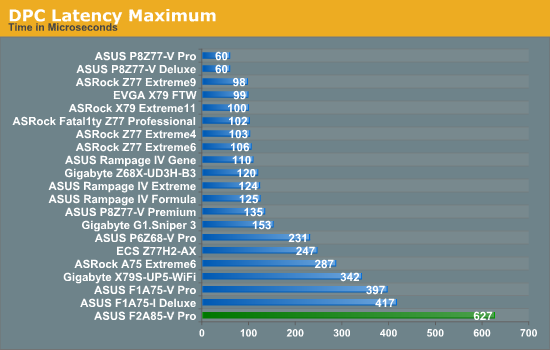
Normally our DPC Latency tests can be affected by monitoring software, producing a value north of 1000 microseconds. Anything under 500 is acceptable, and under 200 is great. However the F2A85-V Pro gets a value in the 600s. During the test, the DPC would hover between 100 and 200 most of the time, but every now and again would peak in the 600 region for whatever reason. The system was rebooted a couple of times but this behavior was persistent across boots. As of the 5104 BIOS this would be slightly worrying for audio work.










66 Comments
View All Comments
just4U - Wednesday, October 10, 2012 - link
Have you used ivy bridge or even set up any? Those puppies get quite warm and temperatures are all over the place. Hell I opted for a 2700K just because of that and prices were comparable. Using the 5800 (been working with it a few days now) it runs cool rarely going over 35C and usually staying in the low 20s in my 10 year old lian-li case (/w 3 80mm fans.. doesn't support bigger ones)CeriseCogburn - Saturday, October 13, 2012 - link
amd fanboy fails again. It's getting irritating with your idiocy and lies and pretense as if you know something. You know exactly nothing." In case of single-threaded load processors with different microarchitectures demonstrate dramatically different levels of power consumption. And here we have every right to state that Ivy Bridge microarchitecture is the most energy-efficient among all testing participants. Core i3 manufactured with 22 nm process do win the promised 8-10 W of power from their predecessors and demonstrate overwhelming advantage over the competitor’s offerings. "
No doubt that Core i3 processors from the new 3000 series will make the most energy-efficient systems. Their power consumption and therefore heat dissipation are significantly lower than by all other platforms, and their advantages over the systems with dual-core Sandy Bridge processors is between 10 and 20 W. This makes Core i3 with Ivy Bridge microarchitecture a perfect choice for compact and energy-efficient systems. And, by the way, for these particular systems Intel has special energy-efficient Core i3 CPU modifications with 35 W TDP instead of 55 W.
LOL - the amd fanboy spews his lies, and gets owned, again, after insulting the poster WHO IS CORRECT.
http://www.xbitlabs.com/articles/cpu/display/core-...
aryonoco - Wednesday, October 10, 2012 - link
At a few points in the article, Ian mentions that the chipset supports RAID5 and might therefore be a good candidate for a SOHO NAS system. My question is, does anyone who builds a SOHO NAS system actually use these integrated hardware RAIDs?Sure, nothing beats a good and proper RAID controller, but those cost upward of $300 and from experience, these integrated RAID controllers barely perform well. They are generally much slower than software RAID, and tougher to recover from failures. Nearly everyone I know who has built their own NAS goes for software RAID, and any modern OS has better software RAID than these chipsets generally provide.
The other reason not to consider Trinity for a NAS build is that power consumption is generally a major factor in a device that's 24/7 on, and Ivy Bridge beats Trinity in that regards hands down. Also, Trinity's main advantage over Ivi Bridge, that of a better GPU, is of no use in a NAS.
So, I ask again, is Trinity actually such a good choice for a NAS build? I see a place for it in a HTPC build, but pretty much in nothing else.
zappb - Wednesday, October 10, 2012 - link
Trinity has a lower idle power consumption - depending on the usage scenario, it should be cheaper to run than the ivy bridge in a NASsolarisking - Wednesday, October 10, 2012 - link
Are you guys still working on an iPhone 5 review? It's been weeks!!!Zink - Wednesday, October 10, 2012 - link
If they still don't have that done, how are they going to keep up with all of the Windows releases set to hit in 2 weeks? Flagship Windows phones and tablets probably deserve just as much attention as the iPhone and there are releases covering the whole value spectrum. I hope the iPad Mini doesn't get some 20 page review while windows tablets get the standard windows laptop type review.Snotling - Thursday, October 11, 2012 - link
There won't be an iPad mini... Unless Apple has lost its sense of direction. (which all things considered might be the case)Phiro69 - Wednesday, October 10, 2012 - link
Ian mentions a few times the motherboard - at $140 - appears overpriced for the performance & such. And yes, this Trinity sku is only somewhat comparable to an i3. But isn't the point of Trinity + FM2 to be somewhat future-insulated? As in, drop in another FM2 sku 6-12 months from now and watch your CPU & GPU performance skyrocket? Didn't AMD say FM2 is going to be around for the this gen and the next gen of processors?You might still have to be abit of an AMD fan boy to buy this combo now, but it would make a solid work PC and/or light gaming PC and a year from now, I bet $125 would drop in a huge boost in performance, without having to replace the rest of your system.
Urizane - Monday, October 15, 2012 - link
"But isn't the point of Trinity + FM2 to be somewhat future-insulated?"This depends on whether FM2 fades as quickly as FM1 and the length of time implied by 'somewhat'. Perhaps FM1 was around for 'somewhat' of a long time...maybe.
Mugur - Thursday, October 11, 2012 - link
HTPC - checked.Cheap file-server (8 x SATA 3 ports is great - I wonder whether mATX boards will have all 8) - checked.
Home Office / light gaming - checked.